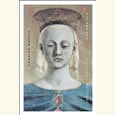Where the Badness Lives
Rebecca Bernard explores dangerous territory in Our Sister Who Will Not Die
In “Harold, Protector of the Children,” a chilling story from Rebecca Bernard’s debut collection, Our Sister Who Will Not Die, the protagonist is a young man who appears unassuming and gentle. But inside, he does battle with troubling desires.

One tactic he uses to bridle these harmful impulses is to locate and watch the homes of registered sex offenders. “Perhaps there’s security in knowing where the badness lives,” Bernard writes, “perhaps he could be its keeper.”
Through stories like “Harold,” Bernard displays a consistent pattern of highly controlled approaches to point of view. By carefully wielding the unexpected perspectives of her protagonists, she creates a fascinating variety of ways to tell stories that engage risky narrative terrain.
Bernard, who earned an M.F.A. at Vanderbilt University, opens up her challenging subjects through a range of storytelling techniques. In some stories, she creates suspense by leading her characters toward ethically complicated decisions. In others, she hews closely to the mindset of abusive or otherwise troubled protagonists. These stories reveal the motivations behind these characters’ choices, one perilous moment after another, often to chilling effect.
The opening pair of stories, “In the Family” and “First Date,” establish Bernard’s penchant for provoking subjects and perspectives. These stories both present middle-aged protagonists who must navigate unusual social dynamics that place their choices under scrutiny — a widow who faces neighborhood criticism after the sudden death of her teenage son and a man who is attempting to go on first dates after the end of a 40-year prison sentence.
 Following these stories are a series of others that portray potentially transgressive protagonists who are pursuing (or resisting) the darker impulses within their psyches. Like the title character in “Harold,” the young child at the center of “Mouse” struggles with unwanted abusive thoughts that he desperately tries to suppress. We know from the start that Mouse has committed a crime of some kind, but the story burrows inside the threatening conflicts of his interior world to make sense of what appears to be a senseless act of violence. Likewise, “Sweat” follows a man whose acts of rage against his girlfriend seem to take him by surprise despite their cyclical pattern.
Following these stories are a series of others that portray potentially transgressive protagonists who are pursuing (or resisting) the darker impulses within their psyches. Like the title character in “Harold,” the young child at the center of “Mouse” struggles with unwanted abusive thoughts that he desperately tries to suppress. We know from the start that Mouse has committed a crime of some kind, but the story burrows inside the threatening conflicts of his interior world to make sense of what appears to be a senseless act of violence. Likewise, “Sweat” follows a man whose acts of rage against his girlfriend seem to take him by surprise despite their cyclical pattern.
A partial exception to this streak of dark protagonists is “The Pleasures of Television,” in which Sandy, a damaged young woman in a small town describes her friendship with a closeted male friend, Beau. The two of them develop an elaborate system of voyeuristic spying. This game, which they call “Watching Television,” brings these two lonely friends closer. But when their peeping leads them to witness a crime far more dangerous than the one they’re committing, they face an ethical disagreement.
When Beau asks Sandy to pinpoint the best part of their questionable pastime, she answers that “the pleasure is knowing that all the time you’re being you, there are all these other people being themselves, and they can’t help it, so neither can we.”
These lines underscore numerous pivotal moments found in Bernard’s stories. Unable to create conventional attachments and intimacy in their lives, these characters often pursue their foundational human needs for connection and understanding through actions that threaten to drive others away, or else to do them harm.
In this way, the title story, “Our Sister Who Will Not Die,” proceeds along a razor’s edge. Its narrator describes six siblings, “now aging and gray,” crammed around the hospice bed of Ellen, their most difficult sibling. Each one takes a turn airing their deepest grievance toward Ellen “to share, in the privacy of family, the pains that a life may give.” The memories they share reveal as much about their own limitations as Ellen’s.
The pointedness of their resentments, spoken over someone who is still breathing but cannot respond, lends the story an air of fraught suspense, almost a sense of voyeurism. But Bernard manages these dynamics with precision and wit.
The final pair of stories bring greater warmth to the whole collection, providing crucial moments of relief from what can feel like an intentionally claustrophobic tone. “We Have Disappeared” is a long story detailing the uneasy affection that the protagonist holds for his longtime friend. While these young men question what to do with their lives beyond their half-assed attendance at community college, they lead each other toward greater danger, even though it masquerades as closeness. By contrast, the young woman who narrates “Gardening” tries her best to keep closeness at bay, even as she considers how to save her wounded marriage.
Our Sister Who Will Not Die will appeal best to readers who are drawn to characters with precarious footholds on social acceptance, or even on reality. Bernard trains her clear-eyed focus onto her characters’ treacherous inner landscapes, neither absolving nor condemning their choices.

Emily Choate is the fiction editor of Peauxdunque Review and holds an M.F.A. from Sarah Lawrence College. Her fiction and nonfiction have appeared in Mississippi Review, storySouth, Shenandoah, The Florida Review, Rappahannock Review, Atticus Review, Tupelo Quarterly, and elsewhere. She lives near Nashville, where she’s working on a novel.


